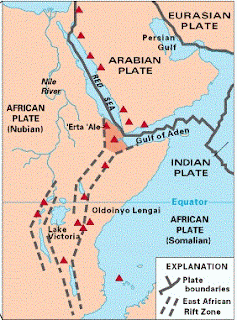 |
| East African triple junction |
Truth be told, Dotson managed to cobble together a few interesting factoids, but it was pretty clear that she was thrashing about in a field she simply did not understand. As a result, her level of misinformation was more than enough to offset any useful information she managed to parrot. For evidence of her bewilderment, we submit the following kernels of misinformation from her post:
- "This huge landmass of crust [Pangaea] moved over Earth’s mantle, which is made of molten rock..." – No, Dianne, not "molten" (even if Burke said so).
- "Eventually, the radioactivity of the mantle, with its heating and cooling cycles, caused the giant continent of Pangaea to break apart..." – No, Diane, there are no "heating and cooling cycles": tectonic motion is caused by convection cells in the mantle.
- "The African Plate is... a dynamic place of earthquakes, rifts and even counterclockwise splitting." – We're at a loss as to the significance of "counterclockwise splitting." After all, "splitting" is the result of the "rifts" Dotson mentioned.
- "There are about 20 tectonic plates..." – Well, maybe. There are seven major plates for sure, plus a handful or two of plates that are mostly consumed by subduction (e.g., the Nazca and Juan de Fuca plates).
- "Plate boundaries... are changeable [sic] areas of the Earth’s crust that create earthquakes and form volcanoes, where the magma from inside Earth can spill onto the crust from plate intersections." – J. Dianne seems to think (see above) that there is a sea of magma under the crust when in the real world, scientists know that magma is (simplistically speaking) created by melting of subducted crust at convergent boundaries and by the release of pressure on the mantle at divergent boundaries.
- "Many countries sit atop the African Plate..." – So what?
- "In Northern Ethiopia, there is a Y-shaped rift. Another region of activity is where the African Plate diverges from the Arabian Plate. " – Idiot, the rift between the African and Arabian Plates is one arm of that "Y-shaped rift" you just mentioned. Learn some geography, huh?
- "The Jordan Rift Valley is where the African Plate has spread away from the Arabian Plate..." – No, Dianne, the Jordan Valley is a failed rift that is now a transform fault.
We'll leave the sting of inanities at that, which we find more than sufficient to earn Dotson the singular honor of our Dumbass of the Day award for her contribution to the stupidification of the internet. With misinformation like that, who needs Twitter?
¹ As in, "You can't spell 'dumbass' without 'DMS.'"
SI - TECTONICS
No comments:
Post a Comment